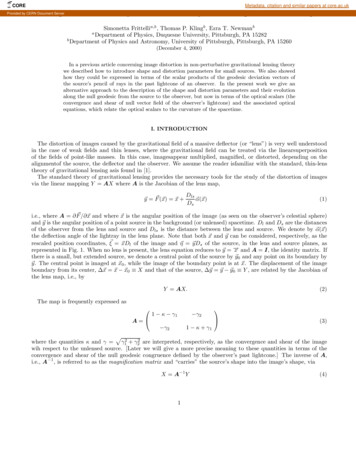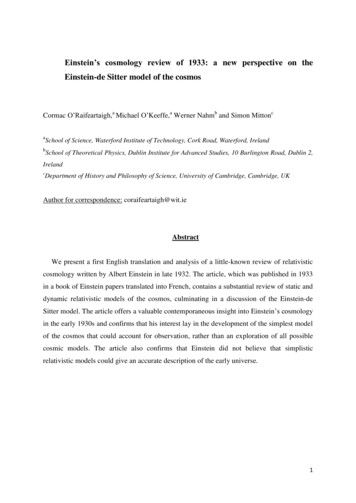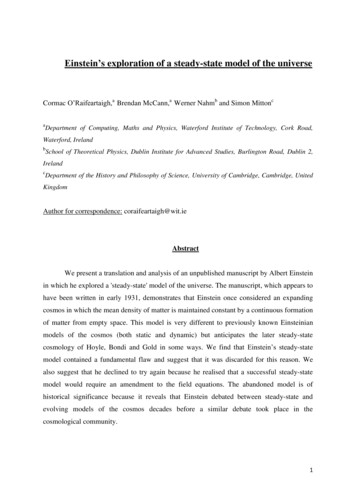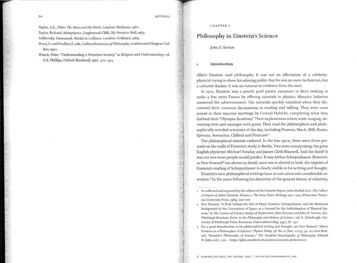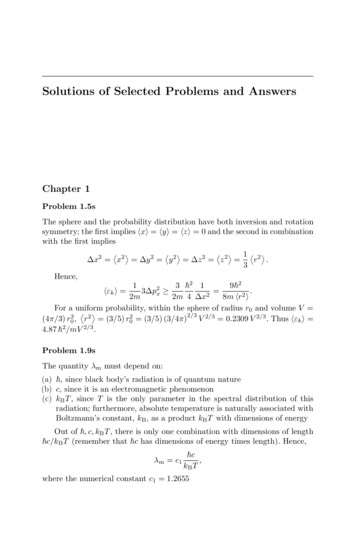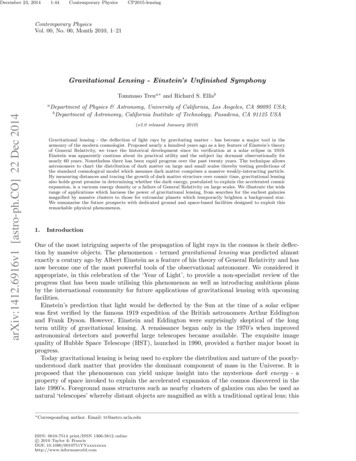
Transcription
December 23, 20141:44Contemporary PhysicsCP2015-lensingContemporary PhysicsVol. 00, No. 00, Month 2010, 1–21Gravitational Lensing - Einstein’s Unfinished SymphonyTommaso Treua and Richard S. EllisbarXiv:1412.6916v1 [astro-ph.CO] 22 Dec 2014aDepartment of Physics & Astronomy, University of California, Los Angeles, CA 90095 USA;bDepartment of Astronomy, California Institute of Technology, Pasadena, CA 91125 USA(v3.0 released January 2010)Gravitational lensing - the deflection of light rays by gravitating matter - has become a major tool in thearmoury of the modern cosmologist. Proposed nearly a hundred years ago as a key feature of Einstein’s theoryof General Relativity, we trace the historical development since its verification at a solar eclipse in 1919.Einstein was apparently cautious about its practical utility and the subject lay dormant observationally fornearly 60 years. Nonetheless there has been rapid progress over the past twenty years. The technique allowsastronomers to chart the distribution of dark matter on large and small scales thereby testing predictions ofthe standard cosmological model which assumes dark matter comprises a massive weakly-interacting particle.By measuring distances and tracing the growth of dark matter structure over cosmic time, gravitational lensingalso holds great promise in determining whether the dark energy, postulated to explain the accelerated cosmicexpansion, is a vacuum energy density or a failure of General Relativity on large scales. We illustrate the widerange of applications which harness the power of gravitational lensing, from searches for the earliest galaxiesmagnified by massive clusters to those for extrasolar planets which temporarily brighten a background star.We summarise the future prospects with dedicated ground and space-based facilities designed to exploit thisremarkable physical phenomenon.1.IntroductionOne of the most intriguing aspects of the propagation of light rays in the cosmos is their deflection by massive objects. The phenomenon - termed gravitational lensing was predicted almostexactly a century ago by Albert Einstein as a feature of his theory of General Relativity and hasnow become one of the most powerful tools of the observational astronomer. We considered itappropriate, in this celebration of the ‘Year of Light’, to provide a non-specialist review of theprogress that has been made utilising this phenomenon as well as introducing ambitious plansby the international community for future applications of gravitational lensing with upcomingfacilities.Einstein’s prediction that light would be deflected by the Sun at the time of a solar eclipsewas first verified by the famous 1919 expedition of the British astronomers Arthur Eddingtonand Frank Dyson. However, Einstein and Eddington were surprisingly skeptical of the longterm utility of gravitational lensing. A renaissance began only in the 1970’s when improvedastronomical detectors and powerful large telescopes became available. The exquisite imagequality of Hubble Space Telescope (HST), launched in 1990, provided a further major boost inprogress.Today gravitational lensing is being used to explore the distribution and nature of the poorlyunderstood dark matter that provides the dominant component of mass in the Universe. It isproposed that the phenomenon can yield unique insight into the mysterious dark energy - aproperty of space invoked to explain the accelerated expansion of the cosmos discovered in thelate 1990’s. Foreground mass structures such as nearby clusters of galaxies can also be used asnatural ‘telescopes’ whereby distant objects are magnified as with a traditional optical lens; this Correspondingauthor. Email: tt@astro.ucla.eduISSN: 0010-7514 print/ISSN 1366-5812 onlinec 2010 Taylor & FrancisDOI: om
December 23, 20141:44Contemporary Physics2CP2015-lensingTreu & Ellisprovides unique information about galaxies seen at early cosmic times; without gravitationallensing such sources would be too faint to study.Here we will briefly discuss the fascinating history of this phenomenon, explain in simpleterms how gravitational lensing works, review the progress in areas of contemporary interest,and conclude with ambitious plans for future applications. For interested readers there are manyexcellent reviews of gravitational lensing [e.g., 1–4]. A comprehensive commented bibliography,including material suitable from high school to graduate students is given by [5].1.1.A remarkable historyThe earliest known mention of light being deflected by massive objects is the first query inNewton’s Opticks in 1704: ’Do not Bodies act upon Light at a distance, and by their actionbend its Rays; and is not this action strongest at the least distance?” Unfortunately, the querydoes not distinguish between the action of gravity on a corpuscle and more conventional opticalphenomena. Henry Cavendish is credited with the first (unpublished, 1784) calculation of thedeflection angle θ of a corpuscular light ray following a hyperbolic trajectory and the originof the (Newtonian) equation θ 2GM/Rc2 where M is the mass of the deflector and R theradius at which the light ray arrives. Subsequently in 1804, Johann von Soldner published asimilar calculation deriving a deflection of 0.84 arcsec for stars viewed close to the limb of theSun. von Soldner additionally discussed the practicality of verifying this prediction but his work,as well as that of Cavendish, was largely forgotten as the corpuscular theory of radiation wasincreasingly discredited in favour of wave theories of light. Not only was there confusion as towhether a deflection was expected for a light wave but the small deflection was also consideredunobservable.In 1911, Einstein calculated a relativistic version of the solar deflection and derived a similarresult to that achieved by von Soldner a hundred years earlier, 0.875 arcsec. However, the physicalprinciples behind the two calculations are quite different. In the classical calculation, it is assumedthat light can be accelerated and decelerated like a normal mass particle, whereas in Einstein’scalculation the deflection is based on gravitational time dilation. In 1915, Einstein considered theadditional deflection arising from the curvature of space around the Sun in his newly-publishedGeneral Theory from which he derived θ 4GM/Rc2 and a solar deflection of 1.75 arcsec.Beginning in 1912, Einstein sought observers who could verify his predicted deflection. Theobservational race to prove or disprove Einstein’s theory is a fascinating story well-documentedin several recent books (e.g. [6][7][8][9]).The Astronomer Royal, Frank Dyson, first proposed the May 29th 1919 eclipse expeditionnoting that the Sun would be in the rich field of the Hyades star cluster. Arthur Eddington hadplayed a key role in promoting Einstein’s theory and took the lead in the organization. Eddingtonand his assistant Cottingham visited the island of Prı́ncipe off the coast of West Africa (nowpart of the democratic republic of Sao Tomé and Prı́ncipe); another team (Crommelin andDavidson) visited Sobral, Brazil. The results, confirming the full deflection, were presented inNovember 1919 ([10]). Although some have argued that Eddington was blinded by his enthusiasmfor Einstein’s theory and biased in his analysis by discarding discrepant data [11], a recent reanalysis by Kennefick [12] shows this was not the case. The rejected Sobral astrograph plateswere out of focus as a result of the rapid change in temperature during totality making it difficultto establish a proper plate scale. In 1979 the Sobral plates were more accurately re-measuredyielding a deflection of 1.55 0.32 arcsec [13].Eddington and Einstein were curiously reticent about possible applications of gravitationallensing. Chwolson [14] illustrated how lensing can produce multiple images of a distant source– a phenomenon now termed strong lensing (§2) but, as its occurrence depends on the precisealignment of a source and deflector, it was reasonable to conclude the probability of observingsuch phenomena would be very small. As a good illustration of thinking at the time, Einstein,urged by Mandl, discussed what Paczynsky later called microlensing – the temporary brightening
December 23, 20141:44Contemporary PhysicsCP2015-lensingContemporary Physics3of a star due to the magnification induced by a foreground object that crosses the line of sightto the observer (§4). In this rare post-1919 article about lensing by its predictor [15], he states“of course there is no hope of observing this phenomenon.”Fritz Zwicky emerges as the worthy prophet by arguing in 1937 that galaxies and galaxyclusters would be far more useful lenses given their greater mass and cross-section to backgroundobjects and, with great vision, foresaw many of the applications we review here [16]. In the 1960s,Barnothy & Barnothy [17] became tireless advocates of Zwicky’s position. The mathematics ofmultiply-imaged geometries was further developed independently by Klimov [18], Liebes [19]and Refsdal. Refsdal [20] demonstrated that if a background lensed source such as a quasaror supernova is variable in its light output, an absolute distance scale can be determined bymeasuring the time delay in the arrival of light observed in its multiple images; this offers ageometric route to measuring the rate of expansion of the Universe.Why did it take so long before further observational progress was made in gravitational lensing? Firstly, gravitational lensing is a relative rare phenomenon in the celestial sky requiringfortuitous alignment of foreground and distant sources. Secondly, as in conventional optics, thebackground source must be substantially more distant than the lens. Until the 1960s, very fewtruly cosmologically-distant sources (i.e. at large redshift1 ) were known. Only as quasar surveysyielded many distant sources in the 1970s did it finally become likely one would be found behind a foreground galaxy. The first example, SBS 0957 561 A/B, was verified spectroscopicallyby Walsh, Carswell & Weymann in 1979 [21]. They discovered two images of the same distant(redshift z 1.413) quasar gravitationally-lensed by a foreground galaxy with redshift z 0.355.Thirdly, surface brightness is conserved in the lensing process (as in conventional optics). However, as surface brightness dims with increased redshift z as (1 z) 4 due to relativistic effectsassociated with the expansion of the Universe, many lensed images viewed through foregroundgalaxy clusters lay undiscovered until the 1980s when efficient digital cameras became commonplace on large ground-based telescopes. The increased sensitivity led to the discovery in the mid1980s of many ‘giant arcs’ - distorted images of background galaxies. For a few years there wassome speculation as to the origin of these strange features. Eventually, Soucail and colleagues[22] confirmed, with a spectrum, that a giant arc in the rich cluster Abell 370 at a redshiftz 0.37 is the distorted image of a single background galaxy at redshift z 0.724. The improvedangular resolution of the Hubble Space Telescope (HST), launched in 1990, was later criticalin recognizing numerous distorted images of faint sources. HST features very prominently inscience programmes exploiting gravitational lensing, for example via its role in conducting deepimaging surveys of foreground clusters for highly-magnified distant objects (Figure 1).1.2.Gravitational lensing and Fermat’s principleFigure 2 provides a useful qualitative overview of the lensing phenomenon. When the lens, forexample a foreground galaxy or cluster of galaxies, is dense enough and well-aligned with abackground source, multiple images of that source can be produced. More generally, when theintervening mass is less concentrated and/or poorly-aligned with the background source, only asmall shape distortion occurs.Quantitively, gravitational lensing can be described in a similar manner to that of standardoptics. The formulation of gravitational optics in terms of a generalized version of Fermat’sprinciple provides a very intuitive way to understand the underlying physics and the basicphenomenology. We give here a brief description of gravitational optics referring to [2] for asummary with equations and to [24] for a more thorough discussion.The mathematic formalism of gravitational lensing can be conveniently described as a transformation between the positions and shapes of background sources as they would be observed1 ‘Redshift’is defined as the factor by which the wavelength of the light of a source is stretched by the cosmic expansionand hence is a valuable measure of its distance, and ‘look-back’ time.
December 23, 20141:44Contemporary Physics4CP2015-lensingTreu & Ellis“Cri3callines” sFigure 1. A striking example of gravitational lensing by a cluster of galaxies. Left: Hubble Space Telescope false colour imageof Abell 2744 revealing many luminous members (white/yellow color) but also numerous background galaxies (typically blue)stretched and distorted by the gravitating mass in the cluster which is dominated by dark matter. The image is taken as partof the Frontier Fields programme . Right: Magnification map inferred via a gravitational lens model for the cluster [23]. Thecluster acts as a natural telescope, so that a distant background source would appear magnified by a factor of 10 or moreif it were to appear near the so-called critical lines (the regions surrounding the cluster centre colored in yellow/white,wheremagnification is very high, formally infinite for a point source). Sources in most of the solid angle behind the cluster aremagnified by a factor of a few. Credits: NASA/ESA and [23].Figure 2. How gravitational lensing works: a foreground cluster of galaxies contains copious amounts of mass (mostly darkmatter) and acts as a gravitational lens, distorting and magnifying the light of a background galaxy. The resulting imageseen by the observer depends on the relative distances between the observer, lens and source, the concentration of mass(dark and visible) in the lens and the degree of alignment of the observer, lens and source. When the alignment and massconcentration is sufficient to create multiple-images of the background source, the phenomenon is called strong lensing. Inthis case the magnification and distortion can be very significant. When the alignment is not so fortuitous, only a modeststretching of a single image may occur ( arclet in the case shown). Quite generally dark matter in the cosmos induces asmall distortion in the shapes of all background galaxies - a phenomenon called weak lensing or cosmic shear.
December 23, 20141:44Contemporary PhysicsCP2015-lensingContemporary Physics5Figure 3. Illustration of gravitational lensing in terms of Fermat’s principle. For a given source position (β), the timedelay surface (black solid lines) is given by the sum of the geometric delay (red dotted lines) and the Shapiro delay (bluedashed lines) as a function of position in the image plane (θ, in units of the Einstein Radius θE , typically one arcsecond forgalaxy-scale lenses). Images then form at the extrema of the time delay surface. The three panels show a section of the timedelay surface in three different regimes of circularly symmetric deflector. Left panel: the source is perfectly aligned with thedeflector (β 0); the time delay has a local maximum at the center and two minima at the same height. This configurationgives rise to a perfect Einstein Ring, with an infinitely demagnified image in the center (see centre panel of Figure 7 forexample). Middle panel: the source is now offset to one side by half an Einstein Radius; the image forming on the outerminimum arrives first, then the central image corresponding to the local maximum, and last the image corresponding to theinner minimum. This configuration gives rise to the classic double configuration, with two bright images and an infinitelydemagnified central image. Right panel: the source is now offset by more than the Einstein Radius; in this case there is onlya minimum and thus only one image, i.e. no strong lensing.in the absence of a deflector (the so-called source plane) and that received by observer (theso-called image plane). The transformation is achromatic and preserves surface brightness [3].The transformation from source to image plane is given by Fermat’s principle. As in conventional optics, photons seem to “choose” special paths from the source to the observer, i.e. imagesform at the extrema of the arrival time surface (usually they pick the shorter time, i.e. minima,but also maxima or saddle points are allowed). However, whereas in standard optics the lighttravel time depends on the speed of light in the material as well as on the path length, in gravitational optics the role of the refractive material is played by the gravitational potential of thedeflector via the so-called Shapiro delay [25], i.e. the delay measured by the observer for a lightray passing through a deep gravitational potential caused by general relativistic time dilation.The competition between the Shapiro delay, which increases with the gravitational potential,and the length of the light path gives rise to the variety of observed phenomena. The descriptionof gravitational lensing in terms of Fermat’s principle is illustrated in Figure 3.Under rare circumstances, if the Shapiro delay is strong enough, multiple images can appearto the observer, giving rise to the phenomenon of strong lensing. In this case the time delaybetween the arrival of light to the various images encodes information about the absolute pathlengths traversed and hence the size of the Universe as function of cosmic time. As we describein Section 2.2, this provides an opportunity for a direct measurement of various cosmologicalparameters. Conversely, if the Shapiro delay is not strong enough to counterbalance the geometricdelay, only a single distorted image of the source appears to the observer. This phenomenon iscalled weak lensing and is a powerful tool to trace the distribution of dark matter outside of theconfines of massive structures like cluster of galaxies (Section 3).2.Strong LensingStrong lensing is perhaps gravitational lensing’s most visually impressive feature. A rich clusterof galaxies such as that in Figure 1 produces striking distorted images of background galaxies
December 23, 201461:44Contemporary PhysicsCP2015-lensingTreu & Elliswhich appear to swirl around the cluster core. Importantly the phenomenon is governed by thetotal mass in the cluster whether it is visible, as in the member galaxies, or dark. As we know thebulk of the gravitating matter in the Universe is in fact invisible, lensing offers us a remarkablypowerful tool to study both the distribution and nature of dark matter.2.1.Lensing anomalies and the nature of dark matterThe standard picture of dark matter is that it is comprised of a massive weakly-interactingor ‘cold’ particle. We know it cannot be baryonic (i.e. quarks) in form as this would violatemeasured abundances of the light elements synthesized in the Big Bang [26], and the observedpower spectrum of cosmic microwave background [27]. Although physicists can attempt, withdifficulty, to capture this weakly-interacting particle and constrain its mass and properties,astronomers have a unique ability to observe the dark matter using gravitational lensing.A very robust prediction of the standard cold dark matter (CDM) cosmological model is thatdark matter congregates in large ‘halos’ within which are numerous satellites or ‘subhalos’. The 1.9abundance of these subhalos should increase rapidly with decreasing mass (dN/dMsub Msub)[28]. This behaviour stems directly from the ‘coldness’ (i.e. low thermal speed) of dark matter inthe standard model. Alternate cosmological models with less massive (or ‘warmer’ ) dark matterparticles [e.g. keV scale sterile neutrino 29] predict a lower mass cutoff to the distribution ofsubhalos [30–32].The luminous satellites surrounding our Milky Way and external galaxies do not appear to benearly as abundant as the predicted distribution of subhalos in CDM, a discrepancy dubbed the‘missing satellite problem’[33, 34](see also [35] for an associated problem). The most favouredsolution is that the lower mass subhalos cannot retain their hydrogen gas and are thus unableto form stars or be seen. This implies that there should be thousands of dark subhalos orbitingour own Milky Way.Given the uncertainties in understanding star formation in low-mass galaxies, it is clear thatonly a direct census of these subhalos by mass can tell us conclusively whether these satellites donot exist or whether they are simply dark. This is a remarkably clean measurement in principle:if the dark subhalos do not exist, the standard cold dark matter model would be ruled out.Gravitational lensing provides a unique opportunity to perform this measurement, by meansof so-called strong lensing anomalies. The presence of dark unseen satellites can be detectedas small scale perturbations in the gravitational potential of a massive galaxy [36–38]. Theseperturbations with respect to an otherwise smooth mass distribution change the arrival time,apparent position, and observed flux of the lensed sources (hence they are named time-delay,astrometric, and flux ratio anomalies, respectively). An illustration of one of the methods isshown in Figure 4.The results so far indicate that the abundance of dark subhalos is consistent with the expectations of CDM models, albeit with large uncertainties [39–42]. This is an area where greatprogress will be possible in the next decade, by studying large numbers of strong lenses at highangular resolution.2.2.Time delays as a probe of dark energyIf the mystery of dark matter was not enough of a problem for the cosmologist, the discovery ofthe accelerated expansion of the Universe in 1999 from the study of distant supernovae [44, 45]raises a new conundrum. Over 70% of the energy density in the Universe is contained in theso-called dark energy - a label used to cover our ignorance of one of the most basic features ofthe Universe. Contemporary thinking suggests dark energy may be a natural property of emptyspace, a vacuum energy density, possibly the cosmological constant initially invoked by Einsteinto retain a static Universe. A key question in considering the nature of dark energy is whetherit is a constant property in cosmic time or whether it evolves. This is central to understanding
December 23, 20141:44Contemporary PhysicsCP2015-lensingContemporary Physics7A!B!ABC!DGGCDFigure 4. Detecting dark matter substructures to test the standard cold dark matter model. The left panels show fourmultiple images (A,B,C and D) of the gravitationally-lensed quasar B1422 231 obtained with the Hubble Space Telescope(leftmost panel) and with the imaging spectrograph OSIRIS behind the adaptive optics system on the W. M. Keck-ITelescope (zoomed in panel). The relative positions and narrow line spectroscopic fluxes of these images measured withOSIRIS contain clues as to the distribution of dark matter in the foreground lens (G). Accurate modelling indicates therequirement for a sub-halo, in addition to the primary one, whose relative position and mass are constrained as shown withthe distribution of black points and orange contours in the right panel. Such positional and flux anomalies can be used totrace dark matter sub-halos with masses of ' 108 solar masses, providing a critical test of the standard model (after [43]).the fate of the Universe.A powerful method to determine the nature of dark energy is to measure the time evolutionof cosmic distances. In the same way as the strength of the Earth’s gravitational field can beinferred from the trajectory of a football, the evolution of physical scales in the universe providesinformation about its total energy densityDistance measurements are critical in cosmology. The supernovae observations that led tothe surprising discovery of an accelerating Universe measured the relative distances betweensupernovae at different redshifts. Likewise, one of the fundamental quantities measured by cosmicmicrowave background satellites such as Planck [46] and WMAP [27] is the distance to the lastscattering surface of the cosmic microwave background at redshifts 1100 (when the universewas 370,000 years old).Strong gravitational lensing of a variable source provides a very elegant one step measurementof absolute distances in the Universe. The difference in arrival time induced by a lens is givenby t D t δφ. Here D t is the so-called time delay distance and encompasses all of thecosmological dependence, and δφ describes the geometry of the system and the gravitationalpotential of the main deflector. By measuring a time delay and determining a mass model forthe main deflector, one obtains the time-delay distance D t and, thus, a determination of thecosmological parameters [20, 47].Refsdal’s idea [20] is fifty years old, but has only very recently been realized as a practicalproposition. His original suggestion involved observing a multiply-imaged supernova, a rare phenomenon. In an exciting development, the first example was observed in 2014 [48, 49, (discoveryimages of the long awaited supernova aptly named ’Refsdal’ are shown in Figure 5]. A more productive endeavour, given the rarity of supernovae, has been the application of Refsdal’s methodto lensed variable quasars. Earlier efforts were first stymied by the shortage of these sources, andlater by the logistical challenges associated with the necessary long-term monitoring of themto measure accurate time delays. However, in the past few years, dedicated monitoring efforts[47, 50–55] and advances in time delay measurements [56, 57] and lens modeling [58–62] have ledto substantial progress. Recent work has shown that a single lens is sufficient to measure absolute distances to 6% precision [63] and thus determine whether dark energy is the cosmologicalconstant or a more exotic phenomenon (Figure 6). In the next decade with many planned widefield surveys and dedicated efforts, thousands of lensed quasars will be discovered and studied,yielding some of the most stringent constraints on the properties of dark energy [64, 65].
December 23, 20141:44Contemporary PhysicsCP2015-lensing8Treu & EllisMACS J1149.6 2223CLASH/GLASS! Feb 20141.3GLASS/Frontier Fields!Nov 20141.41.1Difference1.210 arcsecHost!Galaxy!z 1.49Lensing!cluster!member!z 0.544Figure 5. Discovery of the multiply-imaged supernova ’Refsdal’. The left panel shows an image of the cluster of galaxiesMACS J1149.6 2223 taken prior to the explosion of the supernova. The host galaxy at z 1.49 is multiply imaged bythe cluster, forming images 1.1, 1.2, 1.3, 1.4. A portion of the host galaxy is further multiply imaged by a galaxy in thelensing cluster at z 0.544. The right panels zoom in on the multiply imaged supernova, (top) image prior to the supernovaexplosion from the CLASH program (PI: Postman), (middle) discovery image from the GLASS program (PI: Treu), (bottom)difference image revealing four images of the supernova in an ‘Einstein Cross’ configuration. Left panel image credit: NASA,ESA, W. Zheng (JHU), M. Postman (STScI), and the CLASH Team. The right panel image is taken from [48]. Montageand labels courtesy of S.A. 6080H0 [km s-1 Mpc-1]100Figure 6. Constraining the nature of dark energy using gravitational time delays. The leftmost panel shows a Hubble SpaceTelescope image of the multiply-imaged variable quasar RXJ1131-1231 gravitationally-lensed by a foreground galaxy G andits associated satellite S. To its right is a reconstructed image based on a mass model for the lens. Accurate monitoring ofthe three images A, B and C provide an absolute measure of the different path lengths for a light ray through the lens andhence constraints on the present expansion rate of the Universe (Hubble’s constant Ho ) and the equation of state parameter(w; i.e. the ratio between pressure and energy density, w 0 for cold dark matter, w 1/3 for photons, w 1 for acosmological constant) of dark energy as shown in the rightmost panel (after [63]). The dashed contours show the 68%,95%, and 99 % posterior probability density contours based on the cosmic microwave data alone, and the solid contoursshow the improved precision with the inclusion of the time-delay distance measured from RXJ1131-1231.2.3.Stellar and dark matter in massive galaxiesThe idea that all galaxies are surrounded by halos of dark matter became commonplace bythe early 1980s. But how can we quantify the distribution of dark matter around galaxies andverify its role in galaxy formation given it is invisible? Elliptical galaxies are compact and denseand thus serve as excellent gravitational lenses [1]. Using spectroscopic data from the SloanDigital Sky Survey, the Sloan Lens Advanced Camera for Surveys (SLACS) team has so far
December 23, 20141:44Contemporary PhysicsCP2015-lensingContemporary Physics9Figure 7. Examples of strong gravitational lensing by a galaxy. The background sources (blue) are lensed by the foregroundmassive galaxy (yellow) into an almost perfect ‘Einstein ring’. The radius of the ring gives the total mass enclosed witha precision of just a few percent. Combining this geometrical measure with the kinematics of the stars in the foregroundgalaxy, deduced spectroscopically, provides key data on the radial distribution of matter in the lens as well as the nature ofthe stellar population (after [79]).isolated over 100 elliptical galaxies that strongly lens background blue star forming galaxies atz 0.5 1 [66, 67]. Since the redshifts of both the lens and background source are know
observational race to prove or disprove Einstein’s theory is a fascinating story well-documented in several recent books (e.g. [6][7][8][9]). The Astronomer Royal, Frank Dyson, rst proposed the May 29th 1919 eclipse expedition noting that the Sun would be in the
